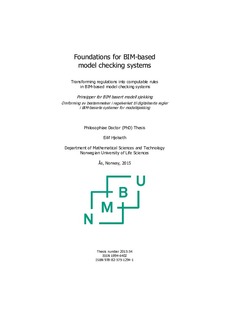| dc.contributor.advisor | Thiis, Thomas Kringlebotn | |
| dc.contributor.advisor | Langdalen, John-Petter | |
| dc.contributor.author | Hjelseth, Eilif | |
| dc.date.accessioned | 2019-01-08T11:52:36Z | |
| dc.date.available | 2019-01-08T11:52:36Z | |
| dc.date.issued | 2019-01-08 | |
| dc.identifier.isbn | 978-82-575-1294-1 | |
| dc.identifier.issn | 1894-6402 | |
| dc.identifier.uri | http://hdl.handle.net/11250/2579671 | |
| dc.description.abstract | Building Information Modelling (BIM)-based model checking is maybe the best way to utilize BIM technology and to contribute to the development of new procedures in the architecture, engineering, and construction (AEC) industry by enabling reuse of knowledge (McHill, 2012). This research seeks to increase the utilisation of BIM-based model checking (BMC) solutions in general, and automated checking of regulations in particular, thereby exploring and suggesting a range of theoretical and practical methods for transforming regulations into applicable digital rules. Regulations include acts and codes with related guidelines and standards.
The target group for use of the developed methods are developers of computable rule specifications – applicable for implementation in applications to be used by the entire construction industry. The specification of the computable rules will then be programmed into software and implemented as new processes for quality assessment of designed solutions or compliance checking.
There has been limited research attention to methods for transforming written building regulations on a large scale into computable rules for BMC that can be specified in an efficient way. This research intends to establish a foundation for the first stage in the development of applicable rules in BMC which can be adapted for use with the major part of the requirements in the regulations which are applicable for digitalisation. Reduction of complexity has been a major guiding star in both the research approach and the development of methods.
The background for this research is deeply rooted in the needs of the AEC industry (architects, engineers, contractors). BMC rules are today mostly focused on clash detection by use of simple geometry-based logic for the conjunction of different parts of building elements like beams and ducts. Free space for a turning circle is another example of a rule based on detection of geometrical conjunction. This type of model-checking replaces visual inspection and the need for information and interpretation is limited. Support of BMC in knowledge-based domains like compliance checking regulations, or compliance with specifications in contracts, is so far limited but is expected to be the new area in BMC. Today’s challenge is therefore to express the regulations in a way that enables valid interpretations of computable rules in BMC. | nb_NO |
| dc.language.iso | eng | nb_NO |
| dc.publisher | Norwegian University of Life Sciences, Ås | |
| dc.relation.ispartofseries | PhD Thesis;2015:54 | |
| dc.title | Foundations for BIM-based model checking systems : transforming regulations into computable rules in BIM-based model checking systems | nb_NO |
| dc.title.alternative | Prinsipper for BIM basert modell sjekking : omforming av bestemmelser i regelverket til digitaliserte regler i BIM-baserte systemer for modellsjekking | nb_NO |
| dc.type | Doctoral thesis | nb_NO |
| dc.source.pagenumber | 1 b. (flere pag.) | nb_NO |
